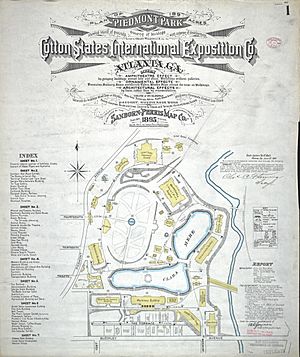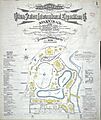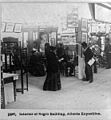Cotton States and International Exposition facts for kids
Quick facts for kids 1895 Atlanta, Georgia |
|
|---|---|
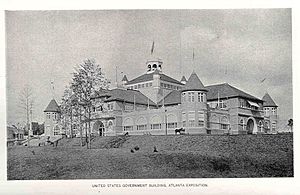
United States Government Building
|
|
| Overview | |
| BIE-class | Unrecognized exposition |
| Name | Cotton States and International Exposition |
| Visitors | 800 000 |
| Participant(s) | |
| Countries | 13 |
| Location | |
| Country | United States |
| City | Atlanta, Georgia |
| Venue | Piedmont Park (now) |
| Coordinates | 33°47′05″N 84°22′30″W / 33.7848009°N 84.3751073°W |
| Timeline | |
| Opening | September 18, 1895 |
| Closure | December 31, 1895 |
| Specialized expositions | |
The 1895 Cotton States and International Exposition was a big world's fair held in Atlanta, Georgia, United States. Its main goal was to help southern states trade with countries in South America. It also wanted to show off the cool products and new ideas from the region to the rest of the U.S. and Europe.
This exposition showed off amazing things from six states. There were new inventions in farming and technology. Special exhibits also highlighted the achievements of women and African Americans. President Grover Cleveland officially opened the fair from his home in Massachusetts. He did this by flipping an electric switch on September 18, 1895!
The event is most famous for the "Atlanta compromise" speech. Booker T. Washington gave this speech on opening day. He talked about how different races could work together.
Contents
How the Fair Started
The idea for a big international fair in Atlanta came from William Hemphill. He was a former mayor of Atlanta. He suggested it in November 1893. Later, he became a vice president and director for the exposition.
A New York architect named Bradford Lee Gilbert was in charge of designing the fairgrounds. He designed many of the main buildings. Joseph Forsyth Johnson designed the outdoor areas. Over $2,000,000 was spent to get the site ready. Lake Clara Meer, which was a small pond, was made much bigger for the event. It grew to about 11.5 acres (4.7 hectares). The fair also created the Tropical Gardens, which are now known as the Atlanta Botanical Garden.
The U.S. government gave $250,000 to build a special government building. Many states and countries, like Argentina, also had their own buildings.
The Exposition was open for 100 days. It ran from September 18 to December 31, 1895. Nearly 800,000 people visited from the U.S. and thirteen other countries. Even with so many visitors, the fair faced some money problems.
Cool Things to See
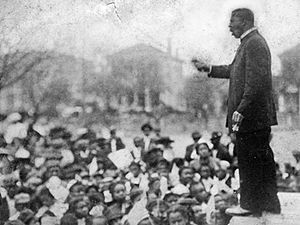
The fair had many different types of exhibits. You could see displays about minerals, farming, food, and new machines. There were also sections for art, education, and literature.
In late September, Charles Francis Jenkins showed off an early movie projector. It was called the "Phantoscope." A famous organist, Fannie Morris Spencer, led the fair's music committee. John Philip Sousa, a well-known composer, wrote his famous march, King Cotton, for the fair. He dedicated it to the people of Georgia.
Walter McElreath wrote about how exciting the fair was. He said the train stations were packed every morning. The streets were full of people all day long. There were street vendors selling all sorts of things. He saw people from all over the world. This included American Indians, people from Circassia, Hindus, and Japanese visitors. They came as entertainers or sellers.
December 26, 1895, was called Negro Day at the Expo. The famous African American quilter Harriet Powers attended this day. She met Irvine Garland Penn, who was in charge of the Negro Building at the fair.
The Woman's Building
The fair had a special building just for women's accomplishments. It was called the Woman's Building. Elise Mercur, Pennsylvania's first woman architect, designed it. The building was in the Palladian style. Women from Georgia organized the exhibitions inside. Women from all over the country contributed items.
The displays showed what women had achieved. This included their work in education, health care, and the arts. Some displays showed traditional roles of Southern women. For example, the Legion of Loyal Women display had 45 dolls. Each doll wore a shield with a state's name. This showed American patriotism. Other displays challenged old ideas about women's roles. The Colonial Room, for instance, showed old tools and furniture. It even had Dolly Madison's glasses and a gun from the Battle of Concord. This display showed how the North and South were starting to work together.
The Woman's Building helped create new ideas for trade and teamwork. It connected the southern states with the northern states. It also showed new ideas and products to the rest of the country and Europe. The exhibits included working models of a hospital room, a nursery, and a kindergarten classroom. There was also a model library. These rooms showed places where women played important roles outside the home. They had the newest equipment and furniture. The library had books by women authors from every state. It also had photos of women writers.
About six thousand exhibits were judged. Beautifully designed medals were given out. The Awards Committee gave out 1,573 medals in total. This included 634 gold, 444 silver, and 495 bronze medals.
Booker T. Washington's Famous Speech
Booker T. Washington gave a very important speech on September 18, 1895. It was about race relations in America. He gave it at the exposition in Atlanta. This speech became the basis for the Atlanta compromise. This was an agreement between African-American leaders and white leaders in the South. It suggested that Black people would work hard and accept white political rule. In return, white people would make sure Black people got basic education and fair treatment by law.
Washington gave this speech to a mostly white audience. It is remembered as one of the most important and talked-about speeches in American history.
What Happened After
The Cotton States Exposition was a success for Atlanta. It showed the city as a great place for business. It also brought new investments to the city.
After the fair ended, the City of Atlanta bought the fairgrounds. This land became Piedmont Park and the Atlanta Botanical Garden. The fair buildings were taken down. However, the park grounds still look much like Joseph Forsyth Johnson designed them. The stone balustrades (decorative railings) scattered around the park are the only remaining parts of the huge main building.
Images for kids


